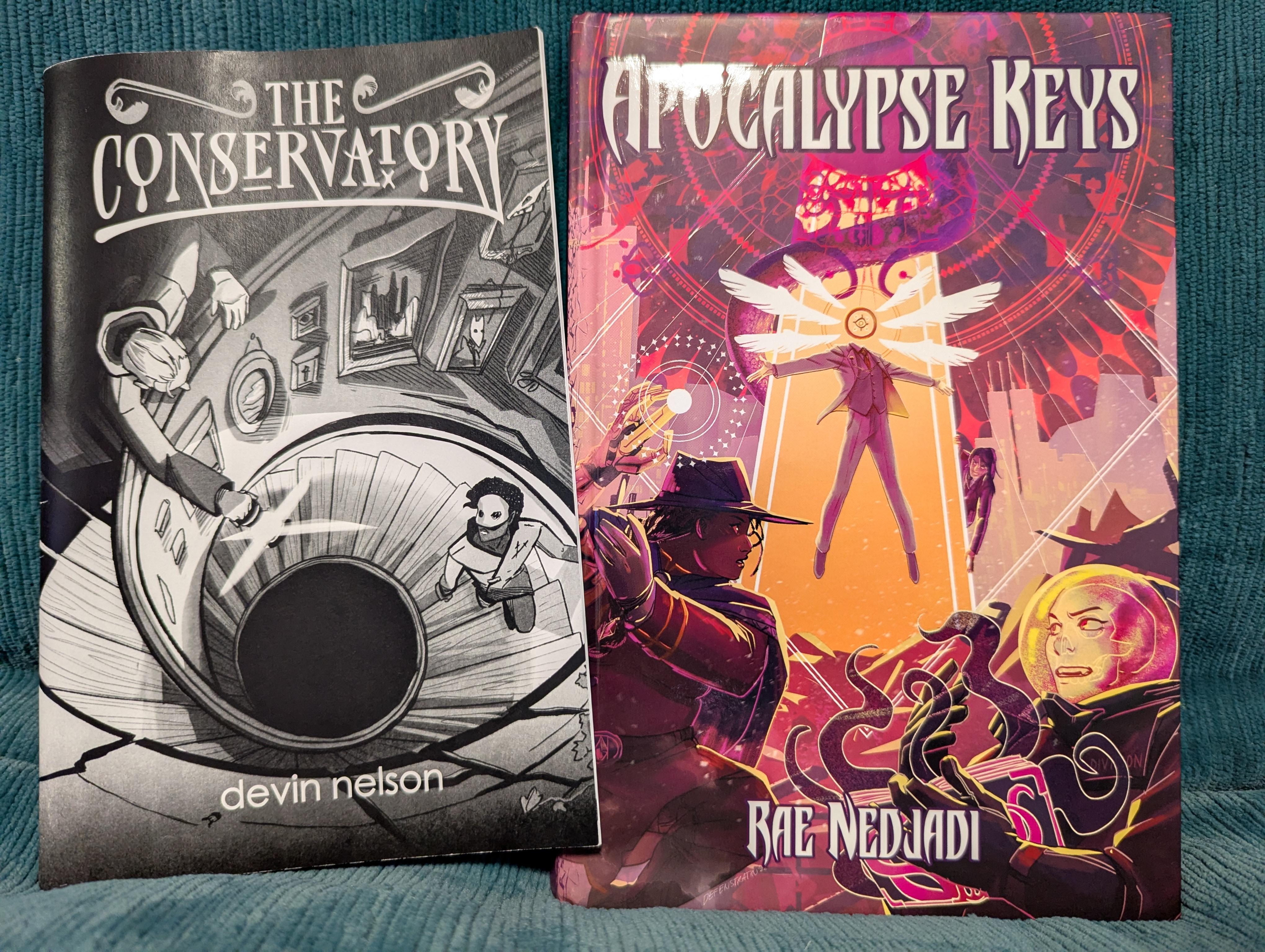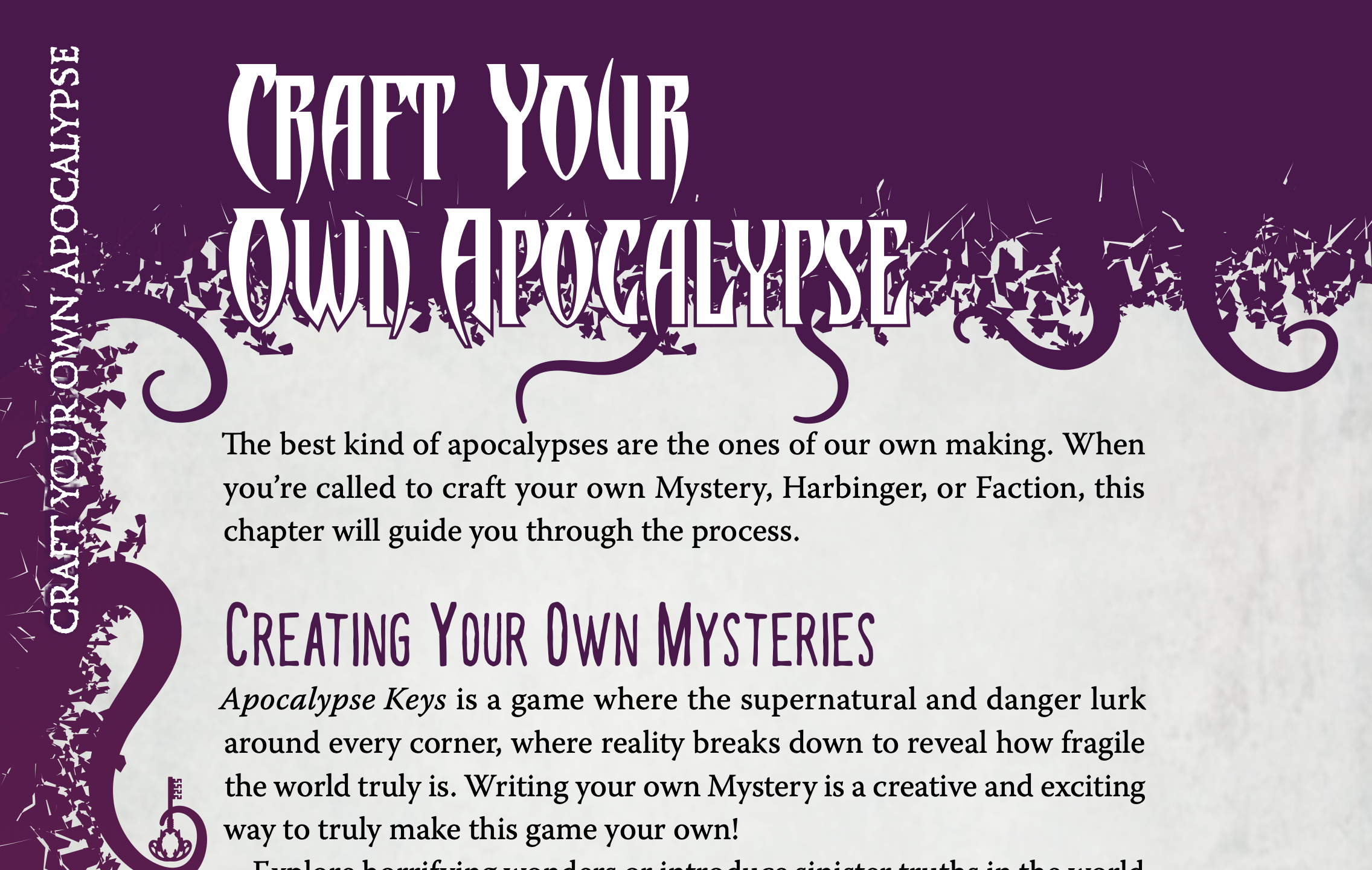
This post is a little bit “play report”, a little bit game critique, and a little bit of reflection on play culture, gm-ing, and game design. I don't think it's my most cohesive and clear-cut writing, but I’m challenging myself to write more frequently and less monolithically. Not everything has to be a full-formed critical essay.
In Search of Mysteries
About a month ago, I wrapped a campaign of Apocalypse Keys by Rae Nedjadi, which I ran for a small group somewhat intermittently from April 2024 to February 2025. Earlier last year, I shared my impressions from running my first Mystery (basically, the first story arc) and upon revisiting it, most of those impressions remain true. Since I started with a prewritten mystery from the book, I was glad to be able to get my bearings and focusing on learning the system and getting to know the player characters.
But after that, I found myself looking past the pre-written mysteries in the book; they’re certainly well-written and evocative, but none were quite suited to my particular party of player characters. Luckily, the Apocalypse Keys is designed to make mystery-writing approachable. It’s essentially a template to fill out, with some guidance on all the ingredients that are necessary to make it work. Not only that, but the prewritten ones make for great examples to follow and pick over for ideas.
So I wrote a new mystery. I gave it a higher Complexity score than our introductory one, which affects the overall pace, and we played through it over 9 sessions. We had a good time and met some memorable characters, but I generally struggled to pace the mystery well across sessions after session. The Complexity score determines the number of clues that must be gathered before the mystery can be fully solved, and the ways our story went confounded the curve of tension and drama that a monster-hunting story ought to have. We got there, but I was dissatisfied with the length and the pacing of my mystery. By the end, the little rural town in which it took place felt simultaneously incomplete and already-picked-over for every detail of interest.

So, for the following mystery, I sought a bigger canvas. I wanted a setting and context that felt wide and explorable, but still distinct and specific. I wanted a plethora of mysterious threads that could be pulled on to keep the wider mystery gradually unraveling, a less isolated and singular space than those first couple mysteries.
The Conservatory
This is around the time when I attended Big Bad Con, and happened to meet Devin Nelson and pick up a copy of one of their games: The Conservatory. At the time, it was one game in a big pile of stuff I’d excitedly accumulated during the convention.
But when I flipped through it at home, it occurred to me that it was exactly what I was looking for: not a mystery setting, but the perfect procedure for building one together with my players. So instead of a new mystery, I brought it to the (very agreeable) table.
The Conservatory is a GM-less storytelling game about occult institutions, their triumphs and defeats, and the ways they intersect with their surrounding communities and change over time. To be quite honest, I might not have had a good grasp on it if not for delving into the Hellboy comics and movies ahead of Apocalypse Keys; in my mind, the genre spaces fit together well. Since we’d already established our setting a little bit, I was optimistic that my players would be along for the ride, at least for one quick session in between Mysteries.
The Conservatory adapts the basic structure of Avery Alder’s The Quiet Year to tell the story of an institution engaged in mysterious occult research. On each turn, players choose from a set of actions that elaborate or change the conservatory, like introducing new “Keepers” (key characters), adding “Wings” (parts of the building itself that carry distinct purposes), and modifying “the Work” (the mysterious occult phenomena or practices that the conservatory pursues). Some actions can be used to introduce new curiosities or embellish existing details, which are interesting choices in their own right, but also make for perfect fallbacks when inspiration is slow to strike.
![Keepers: * Paul Draper (Neophyte [struck through] Shadow Director) - A talented young tap-dancer, one of the first clients taken on by the agency. Seems to be barely touching the floor at all times. Can be found reading and practicing in the Great Hall. * Mariah Mullaney (Practitioner [struck through] Recruiter [struck through] Mentor) - Bartender and talent scout, operates the bar at the speakeasy and has an eye for skilled dancers, experiment candidates, investors, and more. Takes over after Jeremiah retires. * Jeremiah Johanneson (Mentor [struck through] Retired [struck through] Dead, Ghost) - A distinguished elderly gentleman and a key figure in the curse-dance arts. He no longer has the need for spoken words, communicating vividly through dance. A genius and innovator of the Work. Most often in the dark rooms, and rumored to write books in total darkness, which sometimes appear on the shelves in the Great Hall. Retired as he got older. * Lucille Fox (Director [struck through] Escaped Cryptid Office Keeper [struck through]) - A childhood dance prodigy whose career was ended in her teenage years by a leg injury that she never recovered from fully. She’s in search of ways to win back a life she didn’t get to live, one way or another. She can be found in her office, somewhere in the labyrinth of office rooms. After the ruins, she escaped into the hills.](https://thoughtsabout.games/blog/posts/build-partial-worlds/images/the-gdoc.png)
In addition to an action, each player will also draw a card on their turn and resolve whatever events or questions it brings into play. The Conservatory trades away The Quiet Year’s playing card deck in exchange for a tarot deck, using its breadth and thematic flavor to round out the various moving pieces of the game. Face cards introduce new Keepers, ensuring that the enigmatic cast grows, and major arcana introduce Harbingers, impending disasters that the conservatory can attempt to mitigate and must eventually face (also, an amusing terminological overlap with Apocalypse Keys). When enough Harbingers pile up, that “Era” of the conservatory’s history ends and the consequences must be resolved.
The structure of the game gave us a good runway: we set our story nearly a century before the modern day, and we built our strange institution across decades. We placed our conservatory in the LA hills during the golden age of Hollywood: a bizarre dance studio and talent agency obsessively learning dances that would inflict curses upon other people and reality itself. Our story intersected with real-life history in various absurd ways. What I had hoped would be one solid session turned into three enthusiastic and fruitful ones; we constantly delighted in each others’ increasingly strange ideas and characters. By the end, we had an 11-page google doc chronicling our cast of odd characters, the conservatory’s checkered history of careless experimentation and ill-considered manipulation, and a number of unresolved problems that seemed very likely to reassert themselves at some point.
![The Tower [XVI] A physical or metaphysical apocalypse looms in the near future. The Conservatory is the epicenter of this event but the Community will be affected as well.
Answer: what hubris has wrought this end?
Resolution: the Conservatory is in ruins.](https://thoughtsabout.games/blog/posts/build-partial-worlds/images/the-tower.png)
Cursed (Complementary)
Once we put down The Conservatory, it was time for me to go write that new Mystery I’d been putting off. This time, it was easy. There were dangling threads that I could pull on, characters I could bring back and others I could leave mysteriously absent, echoes of the conservatory’s past that were sure to rear their ugly heads. I had all the ingredients I needed, and it was great fun to balance recurring details that players would be excited to revisit with wild extrapolations that would surprise them.
Moreover, the transition to and from storytelling game was smoothed over nicely by Apocalypse Keys’ preexisting affinity for player-contributed detail, something I praised about it in my initial impression. The mysterious sources of otherworldly forces that drove our conservatory’s research meshed excellently with Apocalypse Keys’ focus on cosmic, unknowable, and unpredictable powers.
In some of the most visible surfaces of indie TTRPG play culture, world-building games often supplement campaign-driven play by forming a foundation. The Quiet Year, in particular, has been played on several high profile Actual Play shows as a way to establish a setting full of evocative details, material problems, and enigmatic story hooks. I’ve been drawn to this approach in the past as well, but I find that it heaps a lot of pressure onto a world-building game that may or may not produce something that the whole group is excited to continue exploring.
My experience with The Conservatory and Apocalypse Keys suggests an alteration to this strategy: build partial worlds. Take a few sessions away from an in-progress campaign to collaboratively build a setting for just the next story arc. Do it after you’ve got your campaign underway and all of your players have established their characters, goals, and motivations. They’ll be able to build a setting in anticipation of their character interacting with it, and they’ll be able to weave in themes and ideas that they know their character will be interested in.
Most of my game groups are not recording podcasts or embarking on huge campaigns with months of runway to ideate and prepare. The most planning we tend to do is in choosing games to play and creating characters. I like this partial-world-building approach because it alleviates pressure; if your world-building game just doesn’t quite hit, you can easily leave it on the cutting room floor or scavenge it for parts when you resume your campaign. Or maybe your world-building game was an enormous success, but doesn’t quite fit your ongoing campaign; that’s still fine! Put it in your back pocket. Borrow a character or two for a silly cameo. Write it into your setting, but don’t go there straight away.
Coda
As I understand it, The Quiet Year was never explicitly designed to be a “session 0” game. It’s built with very deliberate edges and its text is abundantly clear about when it invites elaboration and when it encourages fruitful ambiguity or uncertainty. In my opinion, these things make it a stronger game and emphasize its thematic ideas about small communities. But it’s so easy to see why folks play The Quiet Year and want to explore further. Its structure inevitably produces unfinished projects, unresolved mysteries, and uncertain fates. Letting it lie is part of the game… but then the game ends, and maybe you’d like to know more after all.
The Conservatory borrows a lot from The Quiet Year, but one thing it does differently is explicitly invite players to use their conservatory as part of a bigger story if they so choose. I see a lot of world-building games used to start campaigns, but The Conservatory, and certainly many others, can (and should!) be used to augment and revitalize ongoing campaigns too.